Capybaras have a few ways of communicating with humans. They make a wide range of noises to communicate with each other, and humans can interpret these to some extent.
In addition to this, however, capybaras are very intelligent, and many of them quickly pick up on the behavior and habits of their owners. They can also be trained. So this also adds another level of communication between them.
Generally, it is easy to tell if your capybara is happy because they are such expressive animals. They often run around, play, or even jump into the water when they are in a good mood. This is because they love swimming. They will also stand up on their back legs and perform a little dance if they are feeling particularly content.
If your pet is lying flat against the floor or looking sad, it might be in pain or upset about something. You should check your pet over for injuries or take it to the vet for a checkup if you’re concerned about its health.
How Do Humans Communicate With Capybaras?
Humans can communicate with capybaras through language and body language. When communicating with Capybaras, it’s essential to use positive reinforcement. Giving them a treat or belly rub when they do something well will make them more likely to repeat that behavior.
Of course, if you’re training a capybara to perform a trick, the best method is to reward the small steps along the way with treats and praise.
When training your capybara, don’t force him or her into performing a trick. Capybaras are not like dogs and won’t respond well to being pushed around. In addition, don’t be aggressive towards your pet; this will only make them more aggressive as well!
Finally, remember that some capybaras need their space from time to time. If your pet goes off into their cage for some quiet time away from humans and other animals in the house (including dogs), let them have it!
Do Capybaras Understand Commands Given By Humans?
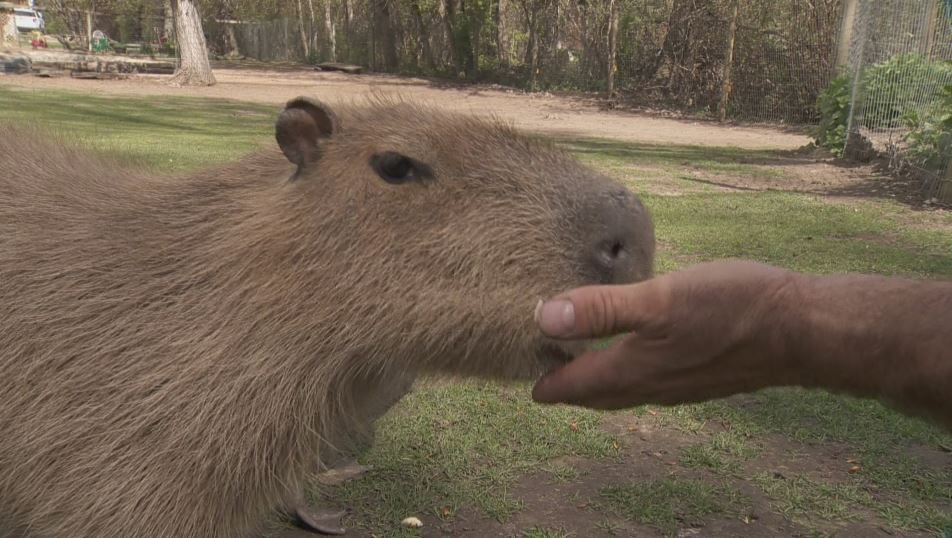
You can train capybaras to do tricks. Just like dogs, they can be trained to swim, sit, and walk on a leash (they’re surprisingly good leash-walkers). You can reward them with treats and praise. Then they will obey your commands.
Capybaras are extremely intelligent animals. They understand commands given by humans. They respond well to the word “no” or a loud clap of the hands. They also understand their names and recognize their owners by voice or sight.
Capybaras have been trained to obey commands. Capybaras understand two-word sentences. They respond to common commands: sit, stay, down and come.
How Do You Know Capybaras Are Empathetic With Their Owner?
It is important to remember that capybaras are highly emotional and empathetic animals. You will have to work hard to ensure they are happy because if they are unhappy, they will let you know.
This can be done by ensuring that you have enough time to spend with them and that they have enough room in your home. The more space they are given, the happier and more excited they will be.
However, if you do not have a good relationship with your capybara, this will lead to stress for both of you. If this happens too often, then your capybara will become depressed and may even die from stress-related illnesses like heart disease or cancer.
This is why it is so important for the owner of a capybara to spend as much time as possible bonding with their pet. If you want your pet to live a long and healthy life, then make sure you spend some quality time together daily!
READ MORE:
How Do Know Capybaras Need Pet?
Capybaras are very social animals and like to be touched, groomed, petted, and scratched by other members of the herd. Sometimes they are unsure what to make of a new petter or groomer because they have not had that experience before.
If you want to pet a capybara to build your relationship with it and make it feel more comfortable around you, gently scratch its head or back. Avoid rubbing its stomach or under its chin.
Some capybaras are shy about being touched in these areas because the fur is thinner there, and some people may accidentally hurt them by touching this sensitive area with too much force.
If your capybara does not seem comfortable with being a pet at first, give it time; if you stay consistent and keep trying every day for several weeks, the animal will eventually become used to it.
How To Know When Capybaras Are Happy?
1. They squeal when they are happy to see you, which is a sign that they are happy
When you come home, your capybara will be so excited to see you that they will run to the door and jump up on their hind legs to greet you. The squealing that accompanies this is a sign of happiness.
You can also tell when they are happy by how they run around with their tails wagging.
2. Their teeth grind when they are excited
- Capybaras have very particular communication skills. When they are excited, they grind their teeth. This is typically a sign of excitement and anticipation but can also indicate anxiety when the capybara is in an unknown or fearful situation.
- When your capybara grins its teeth, it’s trying to tell you something. It might be as simple as wanting you to scratch its belly or go for a walk, or if your pet has been sick recently, it could mean it’s time for a vet visit.
- Pay attention when your capybara goes up to you and starts grinding its teeth! Give some treats and see what happens next. You may even find yourself able to communicate with your pet on a whole new level!
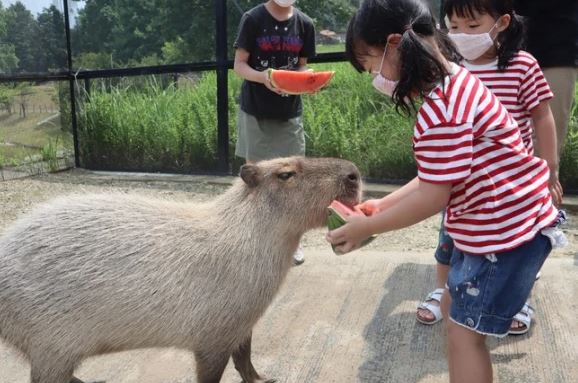
Other ways that capybaras communicate with humans and vice versa
There are many ways that capybaras communicate with humans and vice versa. The most important thing is to be consistent and stick to it. Use the same words for the same actions; otherwise, your pet will get confused.
Avoid using too many methods of communication as well. For example, if you talk to them in English, do not try communicating with them using more than one language, like Spanish or French.
Make sure they understand what you’re saying before you start talking about anything else.
Capybaras Communicate With Each Other through Noises
Like all animals, capybaras communicate with each other. Sometimes in ways that are quite unusual. Capys make various noises, including purring and clicking sounds, as well as sounds like barks, squeaks, and grunts.
Humans can sometimes interpret these sounds as positive or negative noises, such as excited or scared. But there is a lot of debate about whether humans can understand the exact meanings behind these noises from capys.
Do Capybaras Try to Talk to Humans?
Capybaras are known for making some pretty odd noises. Their “barks” sound a bit like a high-pitched dog’s, while their “clucks” or “purrs” sound almost feline. But do these sounds have any meaning? When the animals make them, are they trying to say something?
In this video, a capybara uses several different sounds to communicate with its human companion.
Many guests at the Texas State Aquarium have an enjoyable experience interacting with our capybaras. As you can see from the video, they are very curious animals and often follow visitors around their habitat.
In the past, when they were in a smaller enclosure, they would approach guests if they thought they had food to offer. We discourage this behavior by not feeding them near the edge of the habitat and by not allowing visitors to feed them.
Can Humans Understand What Capybaras Say?
For the past three years, researchers at the University of Sao Paulo in Brazil have been trying to understand the sounds made by capybaras. The researchers wanted to know if humans could understand what they were saying.
The scientists played recordings of capybara noises to university students. The students had to say what they thought the animals were trying to communicate.
Capybara sounds are deep and low-pitched, like a dog’s bark or a whale call. The researchers said that if you were close enough to hear a capybara speak, you could not tell it was coming from an animal. It would just sound like a human having a conversation from far away.
The study showed that even though different humans made different guesses about what the capybaras were saying, “the types of messages perceived were rather consistent.”
The scientists hope their work will help people understand how animals talk and maybe even use new technology to translate animal languages into human ones. But for now, no one knows for sure what these giant rodents are saying when they make their deep growling noises.
How Do You Say Hello in Capybaras Language?
According to the Capybaras Handbook (yes, that’s a thing), there are six ways to say hello in the capybara’s language.
“Hello! I’m hungry”
According to this handbook, this one is pretty self-explanatory. When a capybara approaches you with its ears straight up and nose pointed slightly down, they’re ready for food.
“Hello! I’m curious”
These guys approach you with their noses raised and their ears perked. They would like to know more about you.
“Hello! I’m happy to see you”
The ears go up, and the “nose-tilt” goes up too. You’ve met a friendly capybara and they’re glad you’re around.
“Hello! I’m not sure about this situation”
This greeting is made by tilting your nose down with your ears just on either side of your face. Don’t worry; it shouldn’t be hard to miss if they don’t want to hang out with you — they might even run away if they don’t feel comfortable.
What Do Capybaras Hear When Humans Talk?
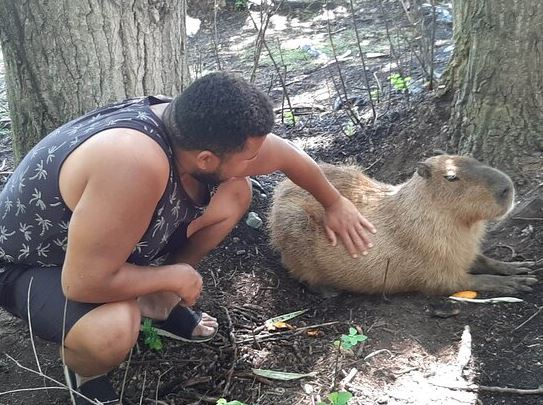
When capybaras hear a human voice, they perk up their ears and are immediately curious. They often tried to find the person talking or looking at them.
In some cases, the capybara reacted in other ways too. She often lay down and rested her head on her paws as she listened to the person speaking. This shows trust and relaxation in capybaras, showing that they feel safe around you. Or sometimes, she even came over to sniff the person who was talking.
During the course of our study, we found that this reaction was consistent, no matter what language was spoken (although some voices may be more interesting than others).
When I heard about these results, I wasn’t surprised at all. My research shows that domestic dogs pay close attention to human speech when directed at them (but not when it’s spoken in general). Our closest primate relatives, chimpanzees, also find human speech interesting. And there are lots of examples of other animals reacting strongly when someone talks directly to them.
New research also suggests that capybaras hear more than we thought they might. That’s because animals have evolved to interpret speech in a way that is similar to humans.
The research, published in the journal Behavioural Processes, found that capybaras are able to tell the difference between vowel and consonant sounds, which is the first step in learning speech.
Previous research has shown that domestic dogs can recognize their owner’s voice, but little scientific research has been done into how other animals interpret human speech.
Conclusion
The capybara is an endearing animal, and it communicates with emotion. Owners of capybaras should learn to communicate with them too. The more comfortable you get with communicating, the better pet owner you will be.
For that reason, communication is something that every capybara lover can benefit from no matter what their experience level. Make your capybara happy, and give him or her an extra verbal pat on the back now and again!


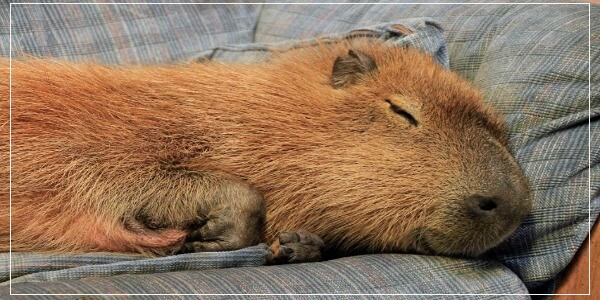
![Do Capybaras Jump - Can Capybaras Jump Up? - [Answered] Can capybaras jump up](https://capybaratips.com/wp-content/uploads/2022/06/Jumping-Capybara.jpg)

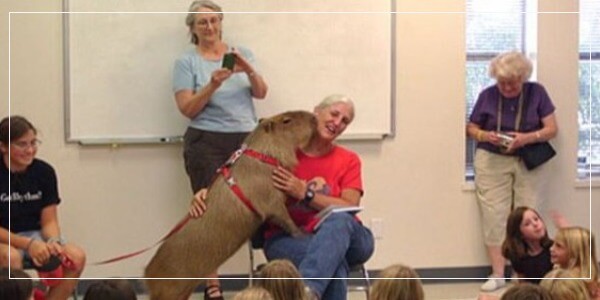


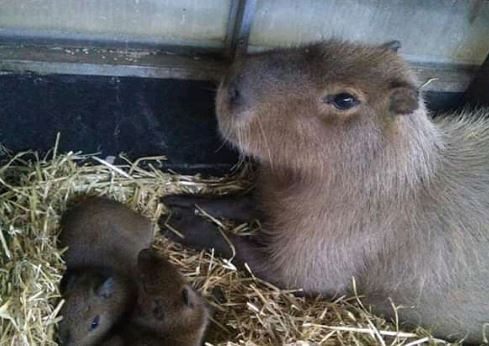
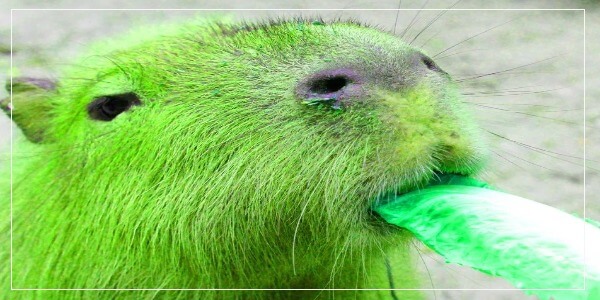
Thank u for all the info I need for my research project.